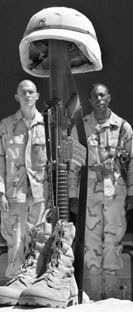What about the other war casualties?
- Neighborhood mourns loss of soldier, worries about more casualties (Times & Democrat)
- Casualties in Iraq; The Human Cost of Occupation (Antiwar.com)
WASHINGTON (FinalCallcom)- On a near daily basis, U.S. Central Command reports on the dead and wounded in Iraq as the attacks against American troops are escalating. What they don’t report is the staggering number of casualties that occur when death is not involved, allowing many injuries to go unreported.
The actual number of war casualties in Iraq is the untold story of thousands of men and women returned to America with broken bodies and broken souls. They return with injuries, wounds, physical and mental illnesses.

“Over 6,000 men and women have come home as casualties,” Susan Brewer, president of America’s Heroes of Freedom, told The Final Call. “I don’t know why it’s not being reported. I found out about the tremendous numbers from an officer’s wife and wanted to scream it from the mountaintop.”
Ms. Brewer’s non-profit organization services the sick, wounded and injured, with toiletries and clothing.
The number of casualties maintained by Central Command are only released when requested and are often forgotten by a public focused on the rising number of dead. The number of dead has already surpassed the total numbers killed during the peak of the war.
The number of soldiers wounded in action during the Iraq war (1,124) has doubled the number of wounded during the Persian Gulf War in 1991 (467). For August alone, an average of almost 10 troops a day were injured.
Major Gen. Kevin C. Kiley, commanding general at Walter Reed Army Medical Center, told reporters that there were only two days in July and four in August when the hospital did not admit soldiers injured in Iraq.
Casualties travel on C-17 transport jets from the battlefield to Landstuhl Regional Medical Center in Germany where they are treated and stabilized. From there, they head home.
“All of our soldiers come to Andrews Air Force Base when they are wounded or injured. They are assessed and then transferred to either Walter Reed Army Medical Center or the National Naval Medical Center in Bethesda or shipped back to their home base. The dead go to the Dover Military Morgue,” said Ms. Brewer, who has witnessed countless broken bodies, spirits and minds come through Andrews.
Major Kiley explained that there were five or six times in recent months when all of Walter Reed hospital’s 40 intensive care beds were filled–mostly with those wounded in action.
Reuters news service reported September 12 that the head of U.S. forces in Iraq, Lieutenant-General Ricardo Sanchez, said that during that week, guerrilla attacks were happening at an average rate of 15 a day.
These attacks include small-arms fire, remote-controlled mines, rocket-propelled grenades and, what the Pentagon refers to as, “improvised explosive devices” according to the Washington Post.
The facts of the casualties bear witness to the warning by the Honorable Minister Louis Farrakhan to President George Bush in a letter dated October 30, 2002. He urged Pres. Bush not to pursue war against Iraq and that, “If you did such, you might run into something that your advisors had not thought of or perceived.”
Of the more than 6,000 service members flown home, as reported in the Washington Post, 1,124 were wounded in action, 301 received non-hostile injuries in vehicle and other accidents and thousands make up the balance that became physically and mentally ill.
Many of the soldiers classified as wounded and injured would be among the dead and dying in previous wars. Advanced medical techniques allow them to live today.
Dr. Kiley explained to reporters that high-tech body armor and state-of-the-art battlefield medical procedures are responsible for extending the life of those seriously wounded.
The modern equipment used aboard the USNS Comfort, a Navy hospital, is also important to saving the lives of the wounded and injured.
When the plane arrives at Andrews, the soldiers arrive just as they were taken off the battlefield or wherever their casualty occurred. They come with torn clothes and without supplies. They arrive at the hospital with nothing but what remains of their lives.
Andrews becomes a “medical church” for wounded bodies and souls seeking to be saved. Soldiers transition there and head out for their next place of healing.
“My heart went out to the wounded and injured,” said Ms. Brewer. “I gathered new things for them to use during their three to 72-hour stay at Andrews. I saw a tremendous need and wanted to fill it.”
The need she saw was bullet wounds, amputees, dehydration, illness and much more. “Our nation has to restore these young lives. They need so much,” she said.
“We offer them a seven-day supply of underwear, t-shirts, a jogging suit, toiletries, snacks, a calling card and a headset to listen to something to relax them. Their needs continue beyond what we do. They need so much.”












